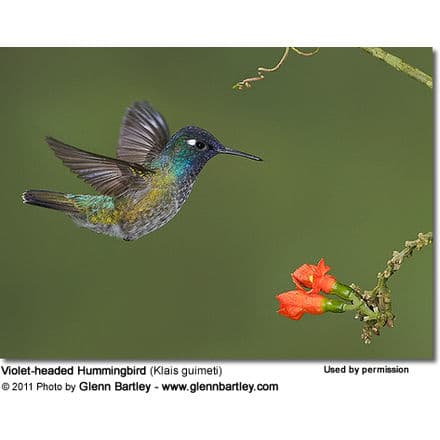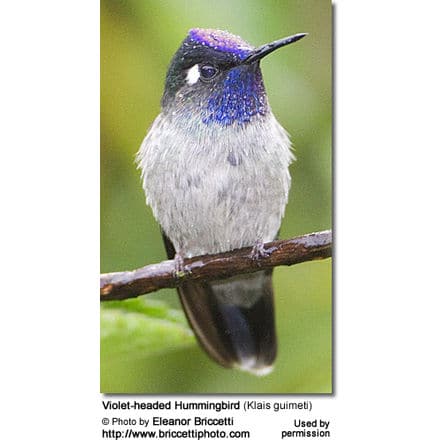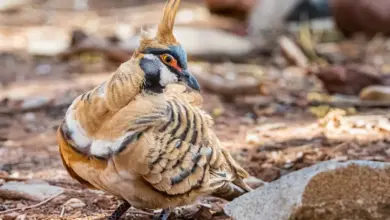Violet-headed Hummingbirds
Hummingbird Information
The Violet-headed Hummingbird (Klais guimeti) is a hummingbird with a natural range from Central America well into South America.
Distribution / Range
In Central America, the Violet-headed Hummingbirds are found in Honduras, Nicaragua, Costa Rica and Panama.
In South America, they occur in western Venezuela, Colombia, Ecuador, Peru, northern Brazil, western Venezuela and northern Bolivia.
The Violet-Headed Hummingbirds are found in the mountains and have been recorded at altitudes from 200 to 850 meters in Costa Rica, from 400 to 1850 meters in Colombia; and 150 to 1900 meters in Venezuela..
They inhabit subtropical or tropical moist lowland forests, moist montanes, and heavily degraded former forest.
Description
The Violet-headed Hummingbird averages 8.1 cm in length, including its tail. It has a short, straight beak that is about 13 mm long.
The male Violet-headed Hummingbird’s head and throat are bright violet or blue (depending on the angle viewed) with white spots behind each eye that contrast with the dark head. The upper plumage is a metallic bluish-green (or bronze-green depending on the angle), while the chest is green fading to a grey abdomen, and the wings are black. His tail is green with tiny white-grey spots.
The female Violet-headed Hummingbird’s plumage is generally duller. Her back is green. Her throat, chest and abdomen are grey. She has a blue cap and white spots behind the eyes. The wings and tail look like the male’s.
Nesting / Breeding
The breeding season usually starts in December with the males commencing their courtship dances to attract females. Male Violet-headed Hummingbirds sing in loose leks (= gathering for the purposes of competitive mating displays), usually beginning in October and intensifying in December. These leks usually take place 5 to 18 meters above the ground on the edge of clearings. At times, a single male may sing solo without other Violet-Headed Hummingbirds nearby.
Hummingbirds are solitary in all aspects of life other than breeding; and the male’s only involvement in the reproductive process is the actual mating with the female. They neither live nor migrate in flocks; and there is no pair bond for this species. Males court females by flying in a u-shaped pattern in front of them. He will separate from the female immediately after copulation. One male may mate with several females. In all likelihood, the female will also mate with several males. The males do not participate in choosing the nest location, building the nest or raising the chicks.
The nesting period generally begins in February, although sometimes as early as January depending on weather conditions – and the young typically fledge in May, which presents the end of the breeding season.
The female Violet-headed Hummingbird is responsible for building the cup-shaped nest out of plant fibers woven together and green moss on the outside for camouflage in a protected location in a shrub, bush or tree. She lines the nest with soft plant fibers, animal hair and feather down, and strengthens the structure with spider webbing and other sticky material, giving it an elastic quality to allow it to stretch to double its size as the chicks grow and need more room. The nest is typically found on a low, skinny horizontal perch about 1 to 5 meters above forested mountain streams.
The average clutch consists of two white eggs, which she incubates alone, while the male defends his territory and the flowers he feeds on. The young are born blind, immobile and without any down.
The female alone protects and feeds the chicks with regurgitated food (mostly partially-digested insects since nectar is an insufficient source of protein for the growing chicks). The female pushes the food down the chicks’ throats with her long bill directly into their stomachs.
The chicks are brooded only the first week or two, and left alone even on cooler nights after about 12 days – probably due to the small nest size. The chicks leave the nest when they are about 20 days old.
Diet / Feeding
They primarily feed on nectar taken from a variety of brightly colored, scented small flowers of trees, herbs, shrubs and epiphytes. They favor flowers with the highest sugar content (often red-colored and tubular-shaped) and seek out, and aggressively protect, those areas containing flowers with high energy nectar. They use their long, extendible, straw-like tongues to retrieve the nectar while hovering with their tails cocked upward as they are licking at the nectar up to 13 times per second. Sometimes they may be seen hanging on the flower while feeding.
Many native and cultivated plants on whose flowers these birds feed heavily rely on them for pollination. The mostly tubular-shaped flowers actually exclude most bees and butterflies from feeding on them and, subsequently, from pollinating the plants.
They may also visit local hummingbird feeders for some sugar water, or drink out of bird baths or water fountains where they will either hover and sip water as it runs over the edge; or they will perch on the edge and drink – like all the other birds; however, they only remain still for a short moment.
They also take some small spiders and insects – important sources of protein particularly needed during the breeding season to ensure the proper development of their young. Insects are often caught in flight (hawking); snatched off leaves or branches, or are taken from spider webs. A nesting female can capture up to 2,000 insects a day.
Males establish feeding territories, where they aggressively chase away other males as well as large insects – such as bumblebees and hawk moths – that want to feed in their territory. They use aerial flights and intimidating displays to defend their territories.
Metabolism and Survival and Flight Adaptions – Amazing Facts
Species Research by Sibylle Johnson
Please Note: The articles or images on this page are the sole property of the authors or photographers. Please contact them directly with respect to any copyright or licensing questions. Thank you.







